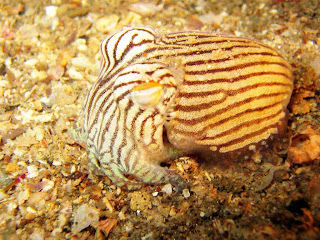Recently, researchers have built a squishy robot that could perfectly camouflage into its surroundings.
The image of the squishy robot
The scientists claim that this robot is based on the characteristics of the squid and starfish, of how they could camouflage into their surroundings perfectly. They also mentions that most of the robots created are generally rigid and large, imitating movements of mammals. However, they discovered that starfish and squids' characteristics could also help in various aspects. They published their research and invention on the current issue of the journal Science.
The materials that these soft robots are made of should be soft and strong, as well as partially transparent since light had to go through it. Hence, they are made of a silicone-based polymer called "poly di methyl siloxane", or PDMS. They were created using 3-D printers, as were the recently added “color layers.”
There are channels attached to the robots that send them colored waters that allow the robot to change its color, depending on the color of the surroundings.
Moreover, by pumping liquids with different temperatures, such as heated or cooled liquids into the channels, the robot could even camouflage in infrared, making the robot more efficient and full of potential.
The scientists claim that the feature to camouflage and to change color can be useful in making search-and-rescue robots. The robots can also serve as a visual marker to assist in finding the crew members. Since the robots are light, yet powerful and less rigid, they can easily go through obstacles such as mud or rocks that heavy and huge robots cannot access. The robot can be made
“They are very light and can make their way across mud in a way that a heavy robot would have trouble with,” Dr. Whitesides, a professor associated with the robot development, said. “A way of seeing a robot there is to make it very visible in the infrared. Since we just need to change the temperature of the liquid flowing into the robot, it is relatively easy to make it visible in infrared."
These robots have gone through various experiments, and they are proven to be able to pick up vulnerable and fragile objects, such as eggs, and even small living things such as live mice. Hence, this characteristics make these robots apt for science research, in environments where the scientists cannot easily access, such as the deep sea floor.
Last but not least, the probably best long term benefit of theses robots is the cheap price. The manufacturing fee causes only around $10, which is very cheap compared to the other robots and easier to make, giving it more potential.
Reflection
After reading this article, I was both amazed by how creative and useful this invention could potentially be, and surprised how many times mother nature have inspired the humans to have another creation in the form of mimicking the behaviors of different species of animals and plants.
I figured out that this invention could be really useful and can be helpful in multiple purposes. Most importantly, I believe that since this robot could camouflage and even remain undetected by the infrared, it can be used for scientific research purposes. All the undiscovered places which includes the deep sea bed and animal habitats, can now be researched, without provoking the surroundings or go there by himself. Some animals are very sensitive to their environment which makes them difficult to study. However, with the help of these robots, which can camouflage perfectly into the environment, the scientists would be able to research the animal species more closely, and even collect a few samples using the robotic arm.
Not only for scientific research purposes, this robot can be also used in search and rescue missions. These robots are small, free and easy to camouflage among the surroundings, it would be able to visit places that people would not be able to go. Hence, these robots can be efficient in finding lost crews and also visit restricted places, traveling easily through obstacles such as mud. I thought that this idea could be very interesting, and in fact, quite valid. If the robots are soft bodied and could squish through obstacles just like squids, why can't they be used as search and rescue robots?
Last but not least, I was amazed by the greatness of mother nature. I realized how many inventions made by humans are actually based on the mother nature: the behaviors of different animals and plants. For example, the airplane is an imitation of the birds flying in the sky and the Bullet Train in Japan is inspired by a Kingfisher bird. (the nose part imitating the beak). A lot of inventions were inspired by what is around us, and this made me astonished, by how great the mother nature can be. Even as the technology develops in a rapid speed, the mother nature still possesses something that humans should learn from, and we humans would always have to observe it carefully.
To summarize, this article helped me to get a wider view of how effective this robot can be and also how much we still need to learn from mother nature.
.



No comments:
Post a Comment